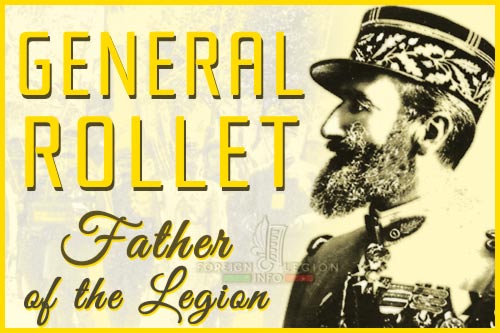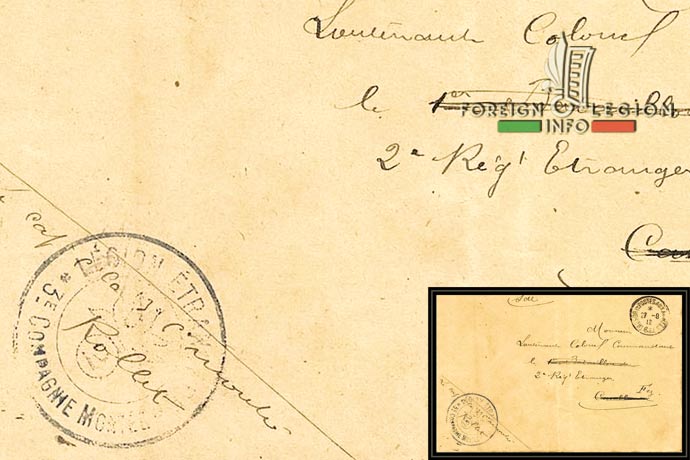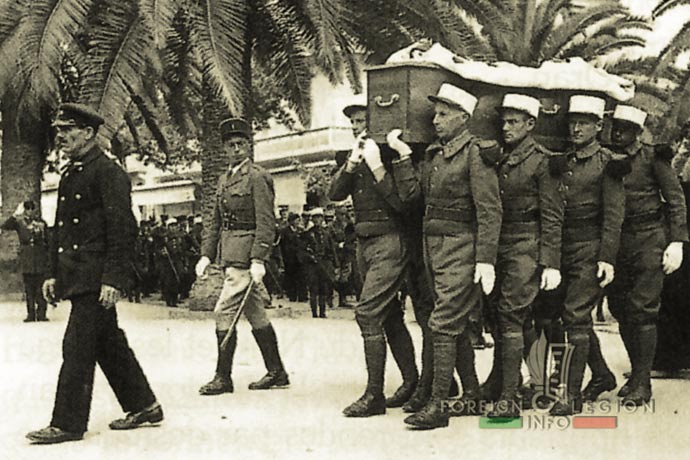On the morning of December 17, 1899, a young lieutenant landed in Algeria for the first time. He was called Paul-Frédéric Rollet, and he was only 24 years old. At the end of the day, he arrived in Sidi Bel Abbès, which was at that time the main garrison of the 1st Foreign Regiment (1er RE), the Foreign Legion’s Motherhouse.

Born on December 20, 1875 in France’s Auxerre, where his father served as a captain in the 46th Infantry Regiment, Paul-Frédéric Rollet also chose a military career and entered the prestigious military academy of Saint-Cyr in October 1894. Promoted to second lieutenant when he graduated two years later, he was assigned to the 91st Infantry Regiment. But the young officer soon grew tired of garrison life in France. He was attracted by France’s colonial conquests in Indochina, Madagascar, West and Equatorial Africa, and by the pacification of the Algerian-Moroccan borderlands. This provoked him to join one of the units operating in these distant territories.
So, as soon as he was promoted to the rank of lieutenant, he obtained permission to serve in the Legion in North Africa. He was to leave it only once, during the tragic days of 1914.
In January 1900, after a short stint with the 21st Company as their instructor for new recruits, Lieutenant Rollet was assigned to the Mounted Company of the 2nd Battalion, 1er RE in South Oran (then a partially unpacified region southwest of Sidi Bel Abbès). He stayed there until November, protecting convoys and doing reconnaissance in the still unknown territory. As soon as he returned to Sidi Bel Abbès, he served with the 18th Company of the 5th Battalion, before leaving for Madagascar in January 1902. Assigned in April to the 2nd Company in the Belo sector, Lieutenant Rollet took part in operations and patrols in the territory of the Sakalaves, and left the island only in March 1905, along with the last units of the Legion.
Back in Algeria, he first took command of the 4th Company of the 1st Battalion, 1st Foreign Regiment in Sidi Bel Abbès, then of a detachment of the 1er RE stationed south of the town, and finally, of the regiment’s disciplinary platoon in Aïn Séfra (the capital of South Oran). At the end of 1906, a few months before the beginning of the French campaign in Morocco, Lieutenant Rollet left for the Algerian-Moroccan border, assigned as a platoon leader to the 3rd Mounted Company based in Berguent.
At the beginning of December 1907, by coincidence, he and his company were replaced there by the 20th Company, 1er RE. This unit would be annihilated by a violent snowstorm two months later near Forthassa (in South Oran). This disaster deeply affected all units of the 1st Foreign Regiment which would remember it. It was the 3rd Company, with Lieutenant Rollet, that was appointed in February 1908 to go to Forthassa in place of its unfortunate sister unit. There they would build a monument commemorating the tragedy.
After operations in the Algerian-Moroccan borderlands (on the Haut Guir, in the territory of Bou Denib, and also between Berguent and Oujda), Rollet was eventually promoted to captain in March 1909, after holding his previous rank for ten long years. He was then assigned to the 2nd Foreign Regiment (2e RE, now 2e REI). Captain Rollet first took command of the 10th Company to move with them to South Oran in June, and then of the 2nd Company in Casablanca, Morocco in March 1910. In October, still in the vicinity of that city, he took over the 3rd Mounted Company, 2e RE (formerly the 22nd Mounted Company). Captain Rollet would command this unit until June 1914, through operations and fighting in Morocco, around Rabat, Kénitra, Fez and Taza. At the same time, his company was carrying out the construction of a fifty-mile (80 km) road from Fez to Bab Tiouka.



While spending his three-month end-of-campaign furlough (an extended leave) in France, his holiday plans were interrupted by the declaration of WWI on August 2, 1914. Captain Rollet then voluntarily left for the front, so as, he said, “not to miss the affair”. Still a member of the Legion, he would be assigned two days later to the 31st Infantry Regiment in Orleans.
On August 22, he was seriously wounded in the face but refused to be evacuated and continued to fight until his complete exhaustion. On September 6, he was wounded again in the head. On October 15, he was appointed major and took command of the newly established 331st Infantry Regiment. But nostalgia for his legionnaires continued to haunt him. From the beginning of hostilities, Rollet had worked in close contact with the Legion. Thus, in the Argonne on January 5, 1915, he organized the second attack of the Bolante Wood jointly with the 4th Regiment Combat Team of the 1st Foreign Regiment (i.e. Garibaldi Legion).
Promoted to lieutenant-colonel in October 1915, Rollet’s dynamism and sense of combat made him, after the heroic death of Colonel Duriez, the new commanding officer of the Foreign Legion Regiment Combat Team (RMLE) in May 1917. This regiment combat team was formed on November 11, 1915 with the survivors of the four Legion combat teams that had been fighting continuously on the Western Front since the beginning of the conflict. Lieutenant Colonel Rollet, still dressed in his legendary khaki canvas uniform, found his legionnaires decimated by the enormous losses suffered in the bloody battles at Aubérive, but still keeping their high morale.
From this handful of men that remained and the reinforcements that he would receive, Lieutenant Colonel Rollet reformed the elite unit. After a relatively calm period, which allowed him to go to Paris and obtain the fourragère in the colors of the Military Medal for the regiment’s flag, the RMLE legionnaires distinguished themselves at Cumières on August 20, 1917. On September 27, the regimental flag was awarded with the Cross of the Legion of Honor, the highest French order of merit. In April 1918, after a further half-rest on the front line, the terrible fighting in Hangard Wood took place.
In May, the legionnaires of the RMLE prevented the enemy from breaking out of Soissons. In June, they made another victorious resistance at Ambleny and Saint-Bandry: the situation was once again saved by the legionnaires. Finally, in August and September, the Legion was the first to attack and pierce the formidable positions of the Hindenburg Line, thus triggering the enemy’s definitive retreat. On September 14, 1918, the fighting was over. Under the command of Lieutenant Colonel Rollet, the RMLE became the most decorated unit in the French army, holding nine mentions in dispatches.
Reformed before returning to Algeria in 1919, his unit was transferred to Morocco in October of the same year, to become the 3rd Foreign Regiment (3e RE, now 3e REI) there in November 1920. Rollet remained its prestigious commanding officer until March 1925.



It was on this date, March 1925, that Lieutenant Colonel Rollet took command of the 1st Foreign Infantry Regiment (1er REI, ex-1er RE) in Sidi Bel Abbès. The main headquarters of the Legion comprised seven battalions at that time. The 1er REI was a very delicate regiment to command, because of the particular missions it had to accomplish in Algeria, Morocco, Indochina and the Levant (Syria and Lebanon). Besides, it was carrying out administration of all Legion personnel and instruction of recruits, legionnaires-specialists and non-commissioned officers.
In late September 1925, Lieutenant Colonel Rollet was promoted to colonel.
The golden age of the Legion began. For six years, Colonel Rollet breathed his ideals into what was already the heart of the Institution. At the same time, he multiplied the inspections of Legion units in Morocco during the final stage of the country’s pacification, in which the legionnaires played a very important role.
Finally, in March 1931, he received his promotion to the rank of brigadier general. But the Legion without Rollet seemed unthinkable, so a compromise was found. The new general took command of the Tlemcen subdivision (west of Sidi Bel Abbès), as well as the title of Inspector of the Foreign Legion, created especially for him. General Rollet thus became the “Father of the Legion”, supervising the whole Legion.
He prepared with all his ardor the Centenary celebrations of April 30, 1931 in the hope that on this 100th anniversary of the Foreign Legion, the whole of France would pay homage to his men whom he knew so well, having commanded them in the hottest moments on the battlefield. The preparation of the anniversary of the Legion also included the realization of a colossal war memorial and its unveiling, as well as the publication of a Golden Book of the Legion (a book dedicated to the famous history of the Legion).
Unfortunately, the celebrations were replaced by sadness the very next year. In September 1932, dozens of legionnaires were killed in a derailed train near Turenne, in northwestern Algeria. General Rollet, who personally took charge of the rescue operations, sadly remarked that “…in a single day, I lost more men than in two years in Morocco.”
Regardless of this tragedy, General Rollet continued to take care of making his Legion known to the general public, as well as taking an interest in the fate of the veterans and bringing about great developments to the Legion veterans associations (so-called Amicales). He would encourage the creation of retirement homes, intervene relentlessly with the authorities to ease formalities for those veterans who wanted to settle in Metropolitan France, and even seek suitable placements for those who were unemployed. Their reclassification in civilian life became his obsession. When the time came to retire, at the end of December 1935, his efforts did not stop and he did not want to rest.
In 1939, Rollet saw the miracle of 1914 happen again, and thousands of foreign volunteers came to fight for their adopted homeland when it was threatened by Germany. Unfortunately, he then had to undergo the ordeal of defeat, which was certainly terrible for a man of his nature who had known nothing but success.
All that remained for the old warlord was to die among the Gueules Cassées (“broken faces”, facially disfigured veterans of World War I), of which his seven wounds and social actions had gained him the presidency in June 1939.
On April 16, 1941, the legendary General Paul-Frédéric Rollet passed away in Paris at the end of a busy life. He had devoted 33 years to the Legion, most of his military career. On April 25, despite the difficult circumstances of the time, his last wish was respected and the “Father of the Legion” was buried among his comrades-in-arms, in the Legion section at the cemetery of Sidi Bel Abbès. In late September 1962, his remains were transferred to southern France to rest in peace in Puyloubier, the site of the Legion Veteran Institution, located not far from Aubagne, the new headquarters of the Foreign Legion.













———
Main information sources:
Képi blanc magazines
Pierre Soulié: Paul-Frédéric Rollet : Père de la Légion étrangère (Editions Italiques, 2007)
Google.com
Wikipedia.org
———

You can support this website at any time through our store. Thank you.
EU-based readers can visit our EU-based shop, to avoid import charges.
—
La version française de cet article: Général Paul-Frédéric Rollet
—
More from the Foreign Legion’s history:
1863 Battle of Camerone
Foreign Legion in the Balkans: 1915-1919
1932 Turenne Rail Accident
1954 Battle of Dien Bien Phu
1976 Loyada Hostage Rescue Mission
1976 Djibouti helicopter crash
1978 Battle of Kolwezi
1982 Mont Garbi Accident
—
The page was updated on: April 17, 2021
